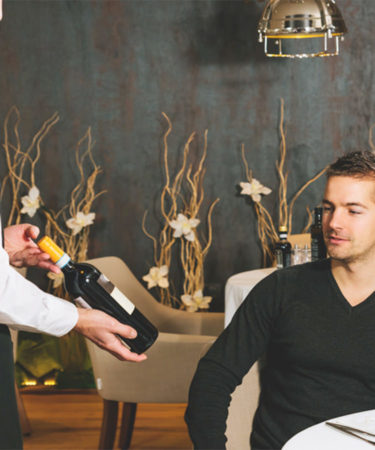The deed has been done, you did the dance with the server or sommelier and your wine has been selected. You now wait with eager anticipation as the wine is brought to the table, but as the server presents the bottle you wonder, why do they hold it for you to inspect and then continue holding it directly in your gaze after the taste has been poured and you begin to go through the motions of tasting? What are you supposed to do?
The presentation of the bottle is both pomp and circumstance, meant to further excite you for your selection and for logistical necessity. When the bottle is presented to you, the server is doing two things, both continuing to get you excited for the wine, and also confirming that this is indeed the wine you think you ordered. While it’s a rarity, every once in a while a bottle opened is not the bottle that was ordered, so confirming this at the beginning helps avoid that awkward conversation when the bill is presented and the wine cost is potentially higher than you thought it should be.
But why does the server continue to hold the label in your view while you begin to taste? You can thank that pesky development known as counterfeiting. As fine wine became increasingly more valuable, nefarious individuals took to counterfeiting it, filling used bottles of fine wine with plonk, and reselling it for high prices. It’s a practice that’s still occurring today, especially in regions where wine prices continue to soar, such as China.
Don't Miss A Drop
Get the latest in beer, wine, and cocktail culture sent straight to your inbox.When the server continues to hold the wine in front of your gaze as you taste, they are checking to make sure you think the wine tastes like the wine that was supposed to be inside the bottle to begin with. It’s a practice that began with high-end fine wine that nobility and the elite of the time were used to drinking on a regular basis – which would explain how they’d be familiar with the taste – and it’s a presentation that’s been continued as wine culture has evolved, applying to all price levels of vino. Even though you may have never had the wine before, allowing you to look at the label as you taste is still the customary and proper thing to do.
This presentation would also be the time to check that the cork you were presented with matches the label, just don’t smell it. You can thank counterfeiting protection for this tradition as well, as counterfeiters would often either put higher end labels on lesser bottles, or use cheap corks to plug the nice bottles they had filled with plonk. So if the cork and label don’t match, there could be an issue.
